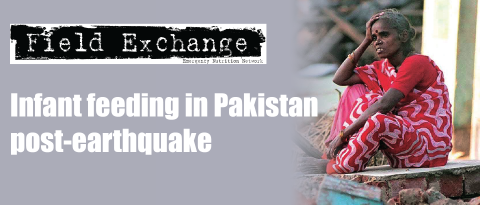Real-time evaluation of WFPs tsunami response
Summary of published report1

Sorting WFP food in Indonesia
The World Food Programme (WFP) recently published the findings of a real-time evaluation (RTE) of their response to the December 26th 2004 tsunami that devastated coastal areas of India, the Maldives, Sri Lanka, Sumatra and Thailand. An estimated 260,000 people were killed or missing and the lives and livelihoods of two million people were seriously affected by the disaster. The evaluation team comprised three individuals, including a nutrition and health specialist. The focus was on the response at regional level and in Indonesia and Sri Lanka.
The main findings were as follows;
The WFP responded rapidly to the emergency. By early January 2005, an emergency operation (Emergency 10405.0) had been approved for an initial six months to the end of June 2005. The two objectives of the emergency operation were;
- To save lives by preventing deterioration of the nutritional status of vulnerable children and mothers.
- To promote the rehabilitation of housing, community infrastructure and livelihoods.
The WFP food aid made a major contribution to achieving the first objective; few deaths were reported from malnutrition or disease. The second objective was more difficult to achieve in the timescale envisaged. Multi-sectoral rehabilitation has been slower than expected, although the food aid did provide a safety net for people in need and an income transfer for displaced people.
Indonesia
The WFP had an established programme in Indonesia but it had limited logistical capacity of its own. For the first few weeks, a private sector partner arranged trucks and got food supplies moving. Despite the WFP's strong initial response, it took some months to develop a systematic food distribution programme because of programming and human resources constraints, as well as the capacity limitations of some implementing partners. Hence, it took longer to reach the estimated 790,000 people identified by the needs assessment. Consequently, the WFP was still building up its caseload at the end of March 2005, when it had been anticipated that the initial emergency phase would be over.
Whilst benefiting the population as a whole, general food distributions (GFDs) made targeted programmes like Food for Work (FFW) more difficult to implement because there was less incentive for people to work or for implementing partners (IPs) to divert resources to design and supervise FFW programmes. Cash for Work (CFW) interventions had started on a modest scale - at the time of the RTE they covered about 15 percent of beneficiaries assisted by the GFDs.
Monitoring was not as strong as it should have been, partly because only one of it's nongovernmental organisation (NGO) partners had a prior presence in Aceh and because all the IPs, like WFP, faced problems such as difficulties recruiting and retaining qualified staff. The government of Indonesia was expected to take the lead in issuing ration cards to internally displaced persons (IDPs), but no ration cards had been distributed in Aceh at the time of the mission's visit, making it difficult for food aid monitors to track assistance.
Supplementary feeding programmes were identified early on as necessary, but they took a long time to establish and were only starting at the time of the mission's visit.
Sri Lanka
It was easier to make a rapid response in Sri Lanka because there was less damage to infrastructures. The WFP had a protracted relief and recovery operation (PRRO) in place in the north and east, areas which were badly affected by the tsunami. WFP diverted 6,000 metric tonnes (MT) of food from the PRRO to the emergency response in the first few days. The WFP's initial assessment found that access to food was a problem for 650,000 people, but concluded that a third would be able to recover their livelihoods relatively quickly. It recommended that general distribution of full rations should cease after three months at the end of March 2005, with only targeted distributions after that date. The government of Sri Lanka initially proposed a higher figure of 900,000 for GFDs, using its network of multipurpose cooperative societies. A consensus was reached that this figure was too high because it included everyone living in or near the areas hit by the tsunami, including people who were only marginally affected.
Common findings

Off loading WFP rice in Indonesia
The tsunami had a greater impact on women than on men - many more women than men were killed. Problems related to gender were emerging at the time of the evaluation. Women were frequently excluded from decision- making in the restructuring. For most people, returning home and economic selfsufficiency were the most important shortterm objectives, but often only men were considered for income-generating activities, free distributions of equipment, vocational training and allocations of land and houses. Slow progress in rehabilitating housing, which has forced many IDPs to remain in overcrowded, isolated and inadequate shelters, was a major cause of vulnerability among women.
A positive aspect of the operation was the large amount of cash available from donors that enabled WFP to purchase food locally or regionally, for example, rice in Indonesia and Sri Lanka.
In both countries, security regulations impeded the emergency response. An excessive number of security rules meant that staff could sometime only work effectively by ignoring them. The Emergency Response Roster (ERR) of WFP stand-by staff for emergencies did not work because not enough suitable staff were available. As a result, the relief operation was sometimes run at the field level by short-term international staff and inexperienced national staff, which had a negative impact on implementation and monitoring.
1Real-Time Evaluation of WFP's Response to the Indian Ocean Tsunami (WFP/EB.2/2005/6-C/Rev.1). Full report available at http://www.wfp.org/eb/docs/2005/wfp080322~2.pdf
Imported from FEX website


